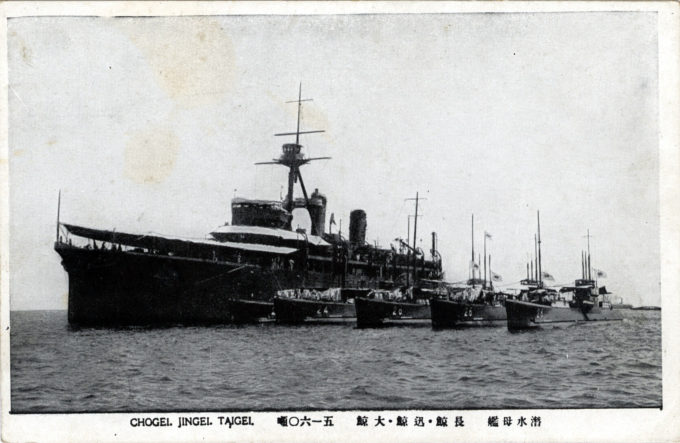
Jingei-class submarine tender, with five Type B1 & Type C submarines berthed alongside (including I-24 and I-26, both with ties to the attack on Pearl Harbor, and I-28). Chogei and Jingei were tenders of the same class, launched 1922-1924; Taigei was a separate class of tender, launched in 1933, that was later converted into an aircraft carrier.
See also:
Taigei-class submarine tender & K6-class submarines, c. 1935
Jingei-class submarine tenders
“The Jingei-class submarine tenders were a class of submarine tenders of the Imperial Japanese Navy (IJN), and served from the 1920s through World War II. Two vessels of this class were built between 1922 and 1924 under the Eight-eight fleet plan: the Jingei and its sister ship, Chōgei, took over the duties of the submarine tenders Karasaki and Komahashi (first launched as Russian passenger-cargo vessels in 1897, and which were acquired as war prizes following the Russo-Japanese War).
“On 19 September 1944, Jingei was torpedoed 80 miles northwest of Naha by USS Scabbardfish. She was towed to Okinawa and beached northwest of Naha, salvaged and scrapped in 1952.
“On 30 July 1945, Chōgei came under attack at Maizuru, taking a direct hit which destroyed her bridge. Following Japan’s surrender in September, 1945, her bridge was repaired, and Chōgei was placed back into service with the Allied Reparation Service, transporting Japanese military and civilian personnel from former Japanese territories back to the Japanese home islands before being removed from service in 1946 and scrapped in 1947.”
– Wikipedia
Type B1 & Type C submarines
“The Type B submarines were derived from the earlier KD6 sub-class of the Kaidai class and were equipped with an aircraft to enhance their scouting ability.
“On 7 December 1941, I-26 sank the 2140-ton U.S. Army chartered lumber freighter Cynthia Olson 300 nautical miles (560 km; 350 mi) off the coast of California — the first American merchant ship to be sunk by a Japanese submarine in the war … I-26 was in Yokosuka’s drydock #5 on 18 April 1942 when one of the Doolittle Raid B-25 Mitchell bombers damaged the carrier Ryūhō in the adjacent drydock #4. … In the evening of 20 June 1942, while patrolling two miles off the coast of British Columbia, I-26 surfaced and shelled the lighthouse and radio-direction-finding (RDF) installation at Estevan Point. This simple act caused a disproportionate effect on coastal shipping, as all lighthouses along the coast were then extinguished for fear of their use by enemy vessels.
“I-28 was sunk by submarine USS Tautog south of Truk on 17 May 1942.
“The Cruiser submarine Type-C were better armed than the preceding Type-A and Type-B submarines. Type-Cs were also utilized as Ko-hyoteki (midget sub) mother ships, for this reason they were not equipped with aviation facilities.
“I-24 was commissioned at Sasebo, Japan on 31 October 1941. She participated in the attack on Pearl Harbor as the mother ship of a midget submarine piloted by Ensign Kazuo Sakamaki, who became the first Japanese prisoner of war when his boat washed up on the shore of Oahu some time after the attack. I-24 also took part in the Battle of the Coral Sea and attack on Sydney Harbour in May and June 1942. I-24 was depth-charged, rammed, and sunk with all hands (104 officers and men) by the United States Navy subchaser USS Larchmont near Shemya, Alaska on 11 June 1943.”
– Wikipedia

